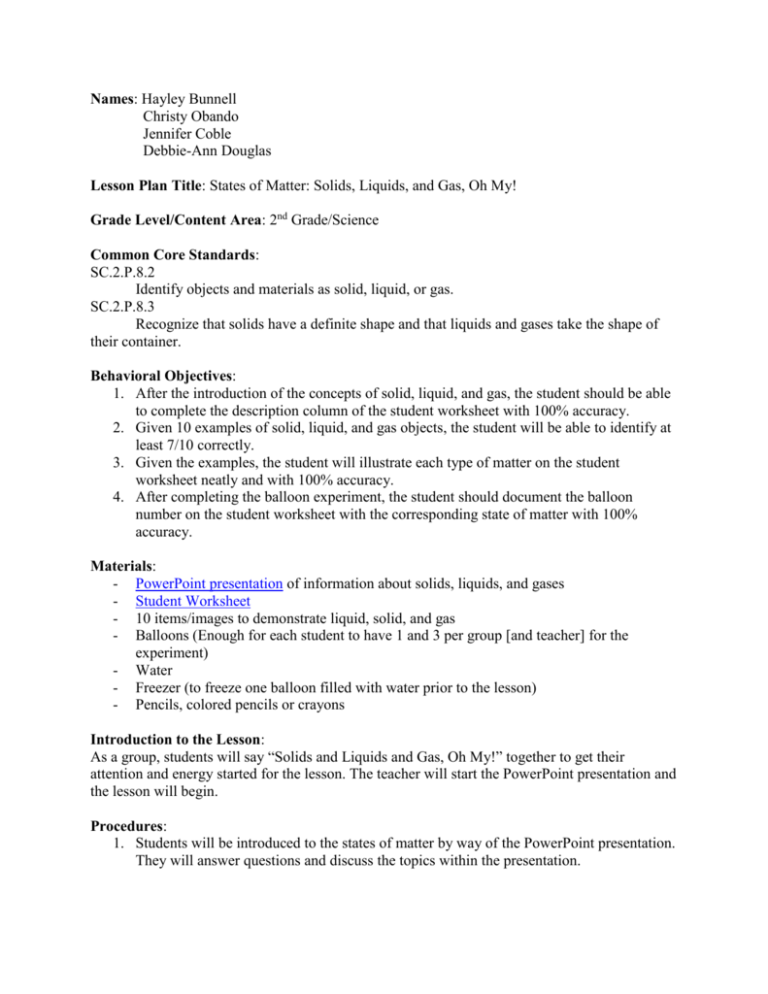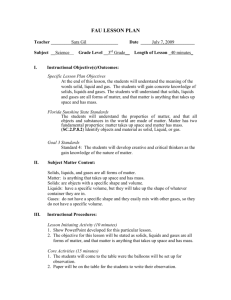"Solids, Liquids, and Gas, Oh My!" Lesson Plan
advertisement

Names: Hayley Bunnell Christy Obando Jennifer Coble Debbie-Ann Douglas Lesson Plan Title: States of Matter: Solids, Liquids, and Gas, Oh My! Grade Level/Content Area: 2nd Grade/Science Common Core Standards: SC.2.P.8.2 Identify objects and materials as solid, liquid, or gas. SC.2.P.8.3 Recognize that solids have a definite shape and that liquids and gases take the shape of their container. Behavioral Objectives: 1. After the introduction of the concepts of solid, liquid, and gas, the student should be able to complete the description column of the student worksheet with 100% accuracy. 2. Given 10 examples of solid, liquid, and gas objects, the student will be able to identify at least 7/10 correctly. 3. Given the examples, the student will illustrate each type of matter on the student worksheet neatly and with 100% accuracy. 4. After completing the balloon experiment, the student should document the balloon number on the student worksheet with the corresponding state of matter with 100% accuracy. Materials: - PowerPoint presentation of information about solids, liquids, and gases - Student Worksheet - 10 items/images to demonstrate liquid, solid, and gas - Balloons (Enough for each student to have 1 and 3 per group [and teacher] for the experiment) - Water - Freezer (to freeze one balloon filled with water prior to the lesson) - Pencils, colored pencils or crayons Introduction to the Lesson: As a group, students will say “Solids and Liquids and Gas, Oh My!” together to get their attention and energy started for the lesson. The teacher will start the PowerPoint presentation and the lesson will begin. Procedures: 1. Students will be introduced to the states of matter by way of the PowerPoint presentation. They will answer questions and discuss the topics within the presentation. 2. After the introduction of the material, students will receive and complete the description column of the student worksheet. 3. The teacher will take out the 10 items/images representing solids, liquids, and gases. One at a time, the teacher will introduce an item and ask students if it’s a solid, liquid, or gas by pulling name sticks. The remaining students will either agree or disagree with that student by doing a teacher specified action (i.e. touch nose with right index finger if agree and cover right ear with left hand if disagree). 4. After seeing several examples of each state of matter students will complete the example portion of student worksheet, providing one example of each state of matter. 5. To introduce the next part of the lesson, students will then each be given an empty balloon. The teacher will have students observe their balloons and introduce it as the container that will be used for the group experiment. 6. Each group will be given the three balloons (numbered) for the experiment. One will be blown up with air (gas), one will be filled with water (liquid), and one will be filled with water and frozen prior to the lesson (solid). Students will carefully observe each, passing the balloons around the group and noting the properties that each possess. 7. Students will then note what number balloon held what state of matter on their student worksheets. 8. The teacher will then ask students what they think will happen to the matter when the container is removed. The teacher and students in the group will carefully cut the balloons one at a time and observe what happens with each. The gas will be released, water will spill, and the ice will keep its shape, illustrating what these states of matter are like when removed from the container. 9. To close the lesson, students will stand up and pass a blown and tied balloon around the room. When they catch it, they will share one thing they learned during the lesson until everyone has had a turn. Independent Practice: Students will be given the homework assignment of making a list of different examples of solids, liquids, and gasses that they see in their homes (naming at least 3 for each). They will then make a poster including these examples to show what they’ve learned. Differentiated Instruction: For ELL students or a student with a learning disability (ADD), the PowerPoint presentation will have many visuals to aid in explanation of the material. Additional time will also be given to complete the student worksheet. Technology Integration: Technology will be incorporated with the use of the PowerPoint presentation. Closure: To close the lesson, students will stand up and pass a blown and tied balloon around the circle. When they catch it, they will share one thing they learned or liked about the lesson until everyone has had a turn. Assessment/Evaluation: Students will be assessed with the completion of the student worksheet. They should have the worksheet completely finished and the content should be accurate. Students will also be assessed on their cooperation during the lesson and experiment. Because the majority of the lesson is hands on and cooperative, if they neglect to follow instructions they’ll be penalized in their final grade. Students will also be graded for the completion of their homework assignment. They will need to have 3 examples of each state of matter on their poster to receive full credit. Connections (Integrations with other subject areas): Prior to this science lesson, the book “What is the World Made Of? All About Solids, Liquids, and Gases” by Kathleen Weidner Zeohfeld can be read together. This can introduce the subject with the story and playful illustration as well as incorporate reading.



